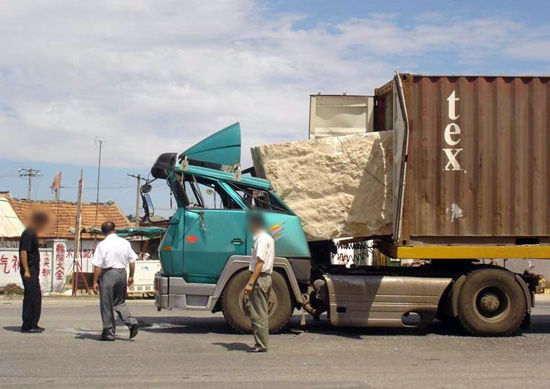| Photo of the month – January 2006 | [German version] |

Figure 1 [source unknown]
Caught between a rock and a hard place!
During a braking maneuver, a slab of stone broke through the front of a container and its kinetic energy was converted to deformation energy at the cab of the tractor unit. The weight of the slab is not known but is assumed to be somewhere between 15 and 20 tonnes.
There’s not much to be said about the load securing except that it was inadequate.
- The first issue is that of load distribution. If the container is a 20′ container and the slab is 4 m long, then it is possible that the distribution of the load is within permissible limits. In the case of a 40′ container, this is unlikely (see section 4.2.1.3 of the Container Handbook).
- Load securing measures: No remainders of belts or wood can be seen. We assume that the slab was loaded in accordance with the ancient wisdom "that’s far too heavy to go anywhere".
Since the load securing points in a container generally only provide a securing force of 1,000 daN, several bracing elements would be required to secure this load (see the information on securing a slab in a container – Container Handbook, section 5.2.14.20).
The picture clearly shows that the container was loaded on the truck with the doors to the front. The container doors must not be used for load securing, as the doors provide virtually no securing force against an unsecured load. A closed end wall would undoubtedly not have prevented the accident, but it would have lessened the consequences considerably.
Remember: Loading a container with the end wall facing towards the driver is always safer, as you never know how well a load has been secured at the other side of the globe.
The truck driver’s responsibility: Whenever it is possible to check the way that a load is secured in a container, it is the driver’s responsibility to do so. If the container shown above was not sealed when it was transported (no customs seal, high-security seal or similar seal), it is the responsibility of both the forwarder and the driver to check that the load is correctly secured in the container. If the load securing is inadequate, measures must be taken to secure the load properly before the consignment continues its journey by road.
- Container selection: The container selected for the job, in this case a standard container, was an unfortunate choice. As a general principle, a flatrack container is a better choice for a load of this type. A flatrack can handle a greater line load, is equipped with stronger load securing points and, because of its open construction, allows quicker, more economical loading and securing. An example of how to secure a load of this type can be found in the Container Handbook, section 5.2.14.13 ff.
Back to beginning
